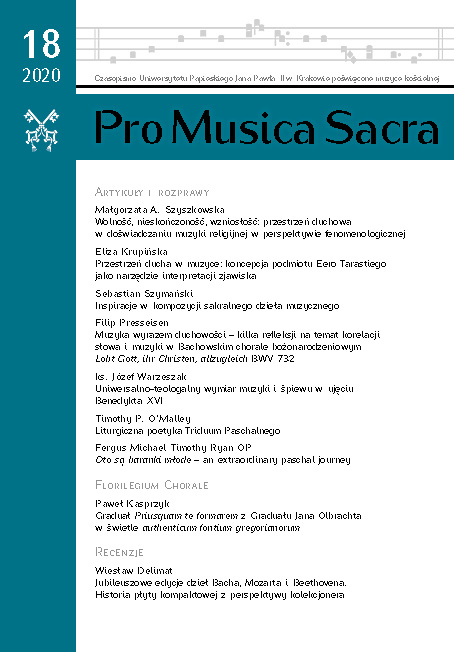Graduale Priusquam te formarem in the context of Authenticum Fontium Gregorianorum
DOI:
https://doi.org/10.15633/pms.3714Keywords:
Gregorian semiology, gregorian chant, gregorian interpretation, Jan Olbracht graduale, melodic restitution, melodic analisysAbstract
Contemporary knowledge on Gregorian Chant is mainly attributed to research conducted on oldest manuscripts. As a result we gained abilities to analyze the transformations which a Gregorian repertoire underwent on the course of ages. One of the most precious liturgical and musical monuments preserved in Poland is a 16th-century Graduale of King Jan Olbracht, stored in Archiwum Kapituły Katedralnej on Wawel, Kraków. Analysis of a graduale Priusquam te formarem for the feast of Birth of John the Baptist shows how an 8th-century melody has been simplified, losing its Gregorian characteristics.
References
Źródła
Graduale Novum, t. 1: De dominincis et festis, Regensburg–Vaticano 2011.
Graduale Novum, t. 2: De feriis et sanctis, Regensburg–Vaticano 2018.
Graduale Romanum, Sacrosanctae Romanae Ecclesiae de tempore et de sanctis, Roma 1908.
Graduał maryjny ms. 44 Jana Olbrachta, Archiwum Krakowskiej Kapituły Katedralnej, faksymile.
Pismo Święte Starego i Nowego Testamentu w przekładzie z języków oryginalnych, oprac. zespół biblistów polskich z inicjatywy benedyktynów tynieckich (Biblia Tysiąclecia), Poznań–Warszawa 1990.
Sobór Watykański II, Konstytucja o liturgii świętej w: https://vademecumliturgiczne.pl/2017/06/26/konstytucja-o-liturgii-swietej-sacrosanctum-concilium/ (30.03.2020).
St. Gallen, Stiftsbibliothek, Cod. Sang. 359: Cantatorium, faksymile.
Ville de Laon, Bibliothèque Municipale, Ms 239: Graduel de Laon, faksymile.
Opracowania
Cardine E., Semiologia gregoriańska, Kraków 2008.
Cardine E., Semiologia Gregoriana, Roma 1979.
Göschl J. B., Graduale Novum Kommentar, Regensburg 2018.
Kasprzyk P., Graduał „Priusquam te formarem” w świetle wybranych źródeł. Praca dyplomowa napisana na Wydziale Historii i Dziedzictwa Kulturowego, Podyplomowe Studia z Monodii Liturgicznej, Kraków 2018.
Klich M., Przebieg melodyczny offertorium „Ave Maria” zachowanego w rękopisie nr 44 Archiwum Krakowskiej Kapituły w świetle wzorców. Praca dyplomowa napisana na Wydziale Historii i Dziedzictwa Kulturowego, Podyplomowe Studia z Monodii Liturgicznej, Kraków 2019.
Miodońska B., Rex Regnum i Rex Poloniae w dekoracji malarskiej Graduału Jana Olbrachta i Pontyfikału E. Ciołka. Z zagadnień ikonografii władzy królewskiej w sztuce polskiej wieku XVI, Kraków 1979.
Popowska M., Graduał maryjny ms. 42 Jana Olbrachta w tradycji krakowskiej – studium źródłoznawcze, Częstochowa 2003.
Saulnier D., The Gregorian Modes, trans. E. Schaefer, Solesmes 2002.
Sławecki M., Główne aspekty śpiewu gregoriańskiego w: M. Bornus-Szczyciński, A. Nowak, M. Sławecki, Monodia, Warszawa 2008.
Downloads
Published
Issue
Section
License
Copyright (c) 2020 Paweł Kasprzyk

This work is licensed under a Creative Commons Attribution 4.0 International License.
Authors who publish with this journal agree to the following terms:
- Authors retain the copyright and full publishing rights without restrictions, and grant the journal right of first publication with the work simultaneously licensed under a Creative Commons Attribution 4.0 International License that allows others to share the work with an acknowledgement of the work's authorship and initial publication in this journal.
- Authors are able to enter into separate, additional contractual arrangements for the non-exclusive distribution of the journal's published version of the work (e.g., post it to an institutional repository or publish it in a book), with an acknowledgement of its initial publication in this journal.
- Authors are permitted and encouraged to post their work online (e.g., in institutional repositories or on their website) prior to and during the submission process, as it can lead to productive exchanges, as well as earlier and greater citation of published work (See The Effect of Open Access).

